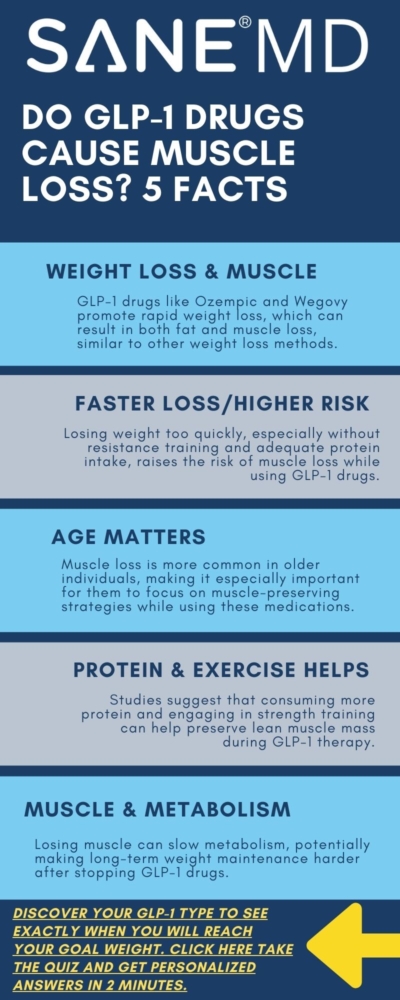Do GLP-1 Drugs Cause Muscle Loss? What You Need to Know
Dr. Matthew Olesiak, MD, is the Chief Medical Director at SANESolution, a renowned wellness technology company dedicated to providing evidence-based solutions for optimal living. Dr. Olesiak earned his medical degree from the prestigious Jagiellonian University Medical College in Kraków, Poland, where he developed a strong foundation in medicine.

GLP-1 receptor agonists, a class of weight loss drugs originally developed for diabetes management, have gained widespread popularity for helping certain people lose weight.
However, concerns have emerged regarding whether GLP-1 drugs cause muscle loss and how they impact overall body composition. Many patients worry that rapid weight loss may result in a reduction in muscle mass rather than just fat mass.
Understanding the effects of these drugs on muscle health is essential for ensuring long-term metabolic function and physical function.
Key Takeaways
- GLP-1 drugs may contribute to muscle loss, but the extent varies based on individual factors, including diet and exercise habits.
- Maintaining muscle mass requires resistance training and adequate protein intake, especially when losing weight rapidly.
- Clinical trials indicate that weight loss with GLP-1 receptor agonists involves both fat loss and lean mass loss, necessitating strategies to preserve muscle.
What Are GLP-1 Drugs?
Glucagon-like peptide-1 (GLP-1) receptor agonists, commonly referred to as GLP-1 drugs, were originally developed to improve insulin sensitivity and aid in blood sugar regulation for individuals with type 2 diabetes. Over time, their ability to promote significant weight loss led to their approval for obesity management. Explore our complete GLP-1 Medications List to learn about the different drugs in this category, their uses, and how they compare.
Popular GLP-1 drugs include semaglutide, liraglutide, and tirzepatide. (If you’re wondering if semaglutide or tirzepatide is better for weight loss, check out our comprehensive guide! These medications help patients lose weight by reducing appetite, slowing gastric emptying, and promoting a feeling of fullness. However, because weight loss can include both fat mass and lean mass loss, there is a concern about losing muscle mass while using these drugs.
Do GLP-1 Drugs Cause Muscle Loss?
The relationship between GLP-1 drugs and muscle loss is complex. Clinical studies show that while patients taking GLP-1 agonists experience significant weight loss, they also lose a portion of lean mass, including muscle mass. This lean mass loss is a common effect of any weight loss intervention, including bariatric surgery and calorie restriction.
“Many patients using GLP-1 agonists achieve rapid weight loss, but without adequate protein intake and resistance training, there is a risk of losing muscle mass along with fat,” says Dr. Matthew Olesiak, MD, Chief Medical Director of SANE MD.
One concern is that rapid weight loss, which often occurs with GLP-1 drugs, may increase the risk of losing muscle mass. Research suggests that GLP-1 medication’s side effects include muscle loss but that patients lost both fat and lean mass at a ratio similar to other weight loss interventions. However, the loss of muscle volume could negatively impact physical function and metabolic rate if not properly managed.
GLP-1 Drugs and Muscle Loss: Key Summary Table
| Factor | Key Information |
|---|---|
| GLP-1 Drugs and Muscle Loss | GLP-1 drugs may cause some muscle loss as part of weight loss, similar to other weight loss methods. |
| Protein Intake | Adequate protein intake (1.2-2.0 g/kg body weight) helps preserve muscle during weight loss. |
| Exercise Routine | Resistance training (at least 2-3 times per week) is crucial for maintaining muscle mass. |
| Rate of Weight Loss | Rapid weight loss (>2 lbs per week) increases the risk of losing lean muscle mass. |
| Age and Muscle Loss | Older adults are more susceptible to muscle loss due to sarcopenia and should focus on protein intake and resistance training. |
| Preserving Muscle Strategies | Engage in strength training, maintain protein intake, and aim for gradual weight loss to reduce muscle loss. |
| Clinical Evidence | Studies indicate that around 25% of weight loss from GLP-1 drugs comes from lean mass, similar to other methods. |
| Risks of Muscle Loss | Muscle loss can lead to decreased metabolic rate, reduced physical function, and increased risk of weight regain. |
| Expert Insight | Dr. Matthew Olesiak emphasizes strength training and proper nutrition to mitigate muscle loss. |
Impact of GLP-1 Drugs on Body Composition
Body composition changes during weight loss are crucial to consider. Clinical trials show that patients taking GLP-1 agonists experience reductions in fat mass and lean body mass. However, skeletal muscle mass loss should be minimized to maintain functional ability and prevent muscle wasting.
Research published in Endocrinology and Metabolism suggests that about 25% of total weight loss may come from lean tissue, including muscle. This percentage is similar to other weight loss methods, such as caloric restriction and bariatric surgery. Ensuring adequate protein intake and incorporating resistance training can help preserve muscle mass and mitigate muscle loss. (NIH)
Factors Influencing Muscle Loss with GLP-1 Drugs
While GLP-1 receptor agonists promote weight loss for compatible individuals, the extent to which they contribute to muscle loss varies between individuals. Several key factors influence whether a person maintains muscle mass or experiences significant lean mass loss while using these drugs.
Understanding these factors can help patients take proactive steps to preserve muscle and optimize body composition during their weight loss journey.
1. Protein Intake: The Foundation of Muscle Preservation
A protein-rich diet is essential for preserving muscle mass while losing weight. Protein provides the necessary amino acids for muscle repair and growth, helping to counteract the loss of lean mass associated with calorie deficits. When individuals do not consume enough protein, their bodies may break down muscle tissue for energy, exacerbating muscle loss.
Clinical trials, including one published in Clinical Nutrition, suggest that individuals aiming to preserve muscle should consume at least 1.2 to 2.0 grams of protein per kilogram of body weight per day (NIH). High-protein foods, such as lean meats, fish, eggs, dairy products, legumes, and plant-based protein sources, can support muscle health.
Additionally, some studies suggest that spreading protein intake evenly throughout the day—rather than consuming the majority in one meal—can further enhance muscle preservation.
A registered dietitian can help develop a meal plan that ensures sufficient protein intake while still promoting effective weight loss.
2. Exercise Routine: The Role of Strength and Resistance Training
Regular exercise is critical for maintaining lean muscle during weight loss. Among various exercise types, resistance training is the most effective way to build muscle and prevent muscle wasting. Strength training stimulates muscle growth and encourages the body to retain lean mass, even in a calorie deficit.
Studies suggest that individuals who incorporate resistance training into their routine experience less muscle loss compared to those who rely solely on dietary changes for weight management. Ideally, people using GLP-1 agonists should engage in strength training at least two to three times per week, focusing on major muscle groups.
Exercises such as weightlifting, bodyweight exercises (push-ups, squats, lunges), and resistance band training can help preserve muscle mass and maintain functional ability.
Aerobic exercise, such as walking, cycling, or swimming, also contributes to overall physical function and energy expenditure. However, to optimize body composition, it should be combined with strength training.
3. Rate of Weight Loss: Why Losing Weight Too Fast Can Be Harmful
While GLP-1 receptor agonists can lead to rapid weight loss, losing weight too quickly may increase the risk of losing muscle and fat mass.
Research suggests that individuals who lose more than 1-2 pounds per week may be at a higher risk of losing lean body mass.
Rapid weight loss often occurs due to a severe caloric deficit, which can force the body to use skeletal muscle mass as an energy source. To mitigate this, experts recommend aiming for gradual weight loss rather than aggressive calorie restriction.
Sustainable weight loss allows the body to adjust gradually, reducing the likelihood of muscle wasting while still promoting fat loss.
Individuals using GLP-1 drugs should work with a healthcare professional to monitor their total weight loss and ensure that they are losing fat rather than lean mass.
4. Age: Muscle Loss Risks for Older Adults
Age is another major factor influencing muscle health and lean mass loss during weight loss. Older adults naturally experience age-related muscle loss, known as sarcopenia, which makes them more vulnerable to losing muscle mass when dieting or taking weight loss drugs.
As people age, their metabolic rate declines and their ability to build muscle decreases due to changes in hormone levels and protein synthesis. To prevent muscle loss, older patients taking GLP-1 agonists should be especially mindful of their protein intake, resistance training, and physical activity.
Maintaining functional ability and bone density is particularly crucial in older adults to reduce fall risk and preserve independence.
By addressing these factors—protein intake, exercise routine, weight loss rate, and age—patients using GLP-1 receptor agonists can develop strategies to mitigate muscle loss, preserve lean body mass, and improve overall body composition while successfully managing their weight.
How to Preserve Muscle While Using GLP-1 Drugs
To prevent muscle loss while using GLP-1 receptor agonists, patients should incorporate lifestyle strategies that focus on muscle preservation and body composition optimization.

1. Resistance Training
Strength training exercises help increase muscle mass and maintain it during weight loss.
Clinical trials show that individuals engaging in resistance training experience less lean mass loss than those who rely on diet alone.
2. Protein-Rich Diet
Increasing protein intake is essential for muscle preservation. Research indicates that consuming between 1.2 and 2.0 grams of protein per kilogram of body weight is beneficial for maintaining lean mass.
A registered dietitian can help create a meal plan that balances protein intake with overall nutritional needs.
3. Gradual Weight Loss
Losing weight at a moderate pace rather than rapid weight loss can help mitigate muscle loss and promote sustainable weight loss.
Patients should aim for a weight loss rate of 1 to 2 pounds per week to preserve muscle.
4. Strength Training and Physical Activity
Engaging in physical activity, including aerobic exercises and strength training, can help maintain lean muscle and improve functional ability.
Strength training exercises are particularly effective at preventing muscle wasting and muscle volume loss.
Clinical Evidence on Muscle Loss and GLP-1 Drugs
Several clinical studies have examined the effects of GLP-1 agonists on muscle health:
- A study published in Endocrinology and Metabolism (NIH) found that participants lost both fat mass and lean tissue, with about 25% of total weight loss coming from lean mass loss.
- Research from the Diabetes, Obesity, and Metabolism journal indicated that skeletal muscle and lean mass loss were consistent with other weight loss interventions but could be mitigated with resistance training and adequate protein intake.
Risks of Muscle Loss with GLP-1 Drugs
While GLP-1 receptor agonists can be highly effective for weight loss, the potential for muscle loss raises important concerns. Losing muscle mass can negatively impact body composition, overall health, and long-term weight management success.
The extent of these effects varies depending on individual factors such as protein intake, exercise habits, and the rate of weight loss. Here’s a closer look at the key risks associated with muscle loss when using GLP-1 drugs.
1. Decreased Metabolic Rate
Muscle is metabolically active tissue, meaning it plays a crucial role in energy expenditure. Losing lean muscle mass can lower the body’s resting metabolic rate, reducing the number of calories burned at rest. This can make it harder to maintain weight loss in the long run, as the body becomes more efficient at storing energy rather than burning it.
Individuals who experience muscle wasting due to rapid weight loss may find it more challenging to continue losing weight and may have an increased risk of regaining weight once they stop taking GLP-1 agonists. Preserving lean mass is essential for sustainable weight loss and preventing weight regain.
2. Reduced Physical Function and Strength
Loss of muscle volume can directly impact physical function, leading to reduced strength, endurance, and overall mobility. Skeletal muscle mass is essential for daily activities, such as walking and lifting objects, maintaining balance, and preventing falls.
In older adults, the loss of lean body mass can significantly impair functional ability, increasing the likelihood of frailty and disability. Ensuring adequate protein intake, resistance training, and regular physical activity can help counteract these effects and mitigate muscle loss while taking GLP-1 agonists.
3. Increased Risk of Weight Regain
Lean mass loss is a concern for individuals using GLP-1 drugs, as it can contribute to weight regain once the medication is discontinued. Clinical studies suggest that maintaining lean tissue is essential for long-term weight management, as muscle mass helps regulate energy balance.
When a significant portion of total weight loss comes from lean body mass rather than fat mass, the body becomes more susceptible to regaining fat tissue when normal eating patterns resume. Strategies to preserve muscle, such as strength training and consuming a protein-rich diet, can help prevent muscle loss and promote fat loss instead.
4. Decline in Bone Density and Increased Fracture Risk
Some clinical trials have suggested that significant weight loss—especially when accompanied by muscle loss—may negatively impact bone density, increasing the risk of fractures. Bone and muscle health are closely linked, and losing muscle mass can contribute to weakened bones over time.
A reduction in fat-free mass and lean tissue may also contribute to fat infiltration in muscles, reducing their efficiency and strength. This can further compromise physical function and increase susceptibility to injuries, particularly in older adults.
To counteract these risks, individuals using GLP-1 agonists should incorporate resistance training, strength training, and weight-bearing exercises to maintain both muscle mass and bone density. Additionally, ensuring adequate protein intake, vitamin D, and calcium can support bone and muscle health during weight loss.
Expert Insight
“Patients should focus on strategies to preserve muscle, including strength training and proper nutrition, to avoid the negative consequences of excessive lean mass loss,” says Dr. Matthew Olesiak, MD.
By taking proactive steps to prevent muscle loss, individuals using GLP-1 receptor agonists can achieve sustainable weight loss while maintaining muscle health, functional ability, and metabolic function for long-term success.
FAQ: GLP-1 Drugs and Muscle Loss
As GLP-1 receptor agonists like semaglutide (Ozempic, Wegovy) and tirzepatide (Mounjaro, Zepbound) gain popularity for weight loss and diabetes management, many people are concerned about their potential impact on muscle mass. Since rapid weight loss can sometimes lead to muscle loss, it’s important to understand how these medications affect the body and how to preserve lean muscle while using them.
Below are answers to common questions about GLP-1 drugs for weight loss and muscle loss.
1. Do GLP-1 drugs make you lose muscle?
GLP-1 receptor agonists can contribute to muscle loss, but this is typically a result of overall weight loss rather than a direct effect of the medication. When people lose weight rapidly, both fat and muscle mass may be reduced, especially if they do not consume enough protein or engage in resistance training. Research suggests that individuals on GLP-1 drugs who do not prioritize muscle-preserving habits may lose a higher proportion of lean mass.
However, maintaining adequate protein intake and engaging in strength-based exercises can help minimize muscle loss.
2. How do you maintain muscle mass while on GLP-1?
To maintain muscle mass while using GLP-1 receptor agonists, it’s important to follow a balanced approach that includes adequate protein intake, resistance training, and proper hydration. Experts recommend consuming at least 1.2–2.0 grams of protein per kilogram of body weight daily to support muscle retention.
Additionally, strength-training exercises such as weightlifting, bodyweight exercises, or resistance band workouts can help preserve and build muscle. Staying hydrated and ensuring sufficient micronutrient intake, such as vitamin D and magnesium, may also support muscle function.
Consulting a healthcare provider or nutritionist can help tailor a plan to minimize muscle loss while maximizing the benefits of GLP-1 therapy.
3. Does semaglutide make you lose muscle mass?
Semaglutide (Ozempic, Wegovy) may contribute to muscle loss as part of the overall weight-loss process. Studies have shown that weight loss with semaglutide includes both fat and lean mass reduction, with some patients losing up to 39% of their weight from muscle.
However, this is not unique to semaglutide—most weight loss, whether from dieting or medication, leads to some degree of muscle loss. Ensuring proper nutrition and engaging in strength-training exercises can significantly reduce the proportion of muscle lost while maximizing fat loss.
4. Does tirzepatide cause muscle wasting?
Tirzepatide (Mounjaro, Zepbound) has been shown to lead to significant weight loss, and like other GLP-1 receptor agonists, some lean mass loss can occur. However, early research suggests that tirzepatide may help preserve muscle better than semaglutide due to its dual action on GLP-1 and GIP receptors, which may have anabolic (muscle-preserving) effects.
Even so, patients who do not engage in muscle-preserving activities such as resistance training and sufficient protein intake may still experience muscle loss.
Regular strength training and proper nutrition are key to maintaining muscle while using tirzepatide.
5. Do GLP-1 agonists cause muscle loss?
GLP-1 receptor agonists do not directly cause muscle loss, but they can contribute to it as part of the weight loss process. Any significant weight loss, regardless of the method, can reduce both fat and muscle mass.
However, the extent of muscle loss largely depends on lifestyle factors, including diet, exercise, and protein intake. Individuals who engage in strength training and consume adequate protein while on GLP-1 therapy can significantly reduce muscle loss and maintain lean body mass.
By taking proactive steps such as eating enough protein, exercising regularly, and staying hydrated, individuals using GLP-1 receptor agonists can preserve muscle mass while still achieving significant weight loss benefits.
Conclusion
Do GLP-1 drugs cause muscle loss? While these medications do not specifically target muscle, weight loss associated with GLP-1 receptor agonists can reduce muscle mass. The extent of muscle loss varies, and factors such as protein intake, exercise, and the rate of weight loss play critical roles in preserving muscle.
To maintain muscle mass while using GLP-1 drugs, individuals should prioritize resistance training, consume sufficient protein, and aim for gradual weight loss. By taking proactive steps, patients can maximize fat loss while minimizing lean mass loss, ensuring long-term metabolic function and physical health.
Scientific References
Endocrinology and Metabolism (NIH)
Diabetes, Obesity, and Metabolism






